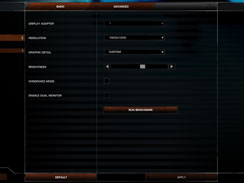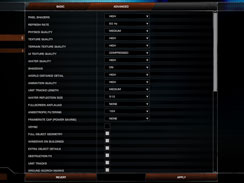World in Conflict
Publisher: SierraWe regard World in Conflict as one of the best real-time strategy games we've ever played. It's based on Microsoft's DirectX 10 API and, in collaboration with Nvidia's The Way It's Meant To Be Played developer support team, it incorporates some DirectX 10 specific graphics effects.
The first of these is a soft particle effect that removes the banding often found in particle effects like smoke, explosions, fire and debris - the effects simply didn't exist in the 3D world; instead, they were merely an add-on. With DirectX 10, the edges of the particle effects are much softer and banding is almost non-existent as the effects now interact with their 3D surroundings, as they're actually a part of the 3D world.
Additionally there are global cloud shadowing and volumetric lighting effects in the DirectX 10 version of the game. The latter is often referred to as 'god rays' and its implementation in World in Conflict interacts with the surroundings incredibly well. On the other hand, the former is where clouds cast shadows on the rest of the environment and, because all clouds in World in Conflict are volumetric and dynamic, the shadows cast by the clouds are rendered dynamically in DirectX 10 - they adjust in relation to the size, shape and orientation of the cloud in relation to the light source.
For our testing purposes, we used a full retail copy of the game and patched it to version 1.005, which includes a few fixes and some improved performance under DirectX 10. We used a manual run through from the Invasion level, which incorporates all of the effects we've discussed above. We chose not to use the built-in benchmark because it's largely CPU-limited. We used the "high" preset, and controlled anti-aliasing and anisotropic filtering via the advanced settings tab.
The GeForce 9600 GT is about 10 to 12 percent faster than the Radeon HD 3870 and Radeon HD 3850 when anti-aliasing is enabled in World in Conflict, but again the three cards are pretty evenly matched when AA is disabled – the 3870 is slightly faster, while the 3850 is slightly slower than the 9600 GT.
The Nvidia GeForce 8800 GT’s performance advantage increases with resolution, proving that this title isn’t quite as fillrate limited as other titles we’ve tested – if anything, it’s a good indicator of what might happen in the future. The performance gap increases from six percent at 1920x1200 0xAA 16xAF to 15 percent when 2xAA is enabled. When the resolution is increased to 2560x1600, the performance gap increases to 20 percent.
World in Conflict does appear to be limited by both memory size and bandwidth though, because the GeForce 8800 GS is quite a bit slower than the GeForce 9600 GT when either AA is applied, or the resolution is high enough. Performance just really drops off, and it’s as if the card is struggling from a lack of memory.

MSI MPG Velox 100R Chassis Review
October 14 2021 | 15:04












Want to comment? Please log in.